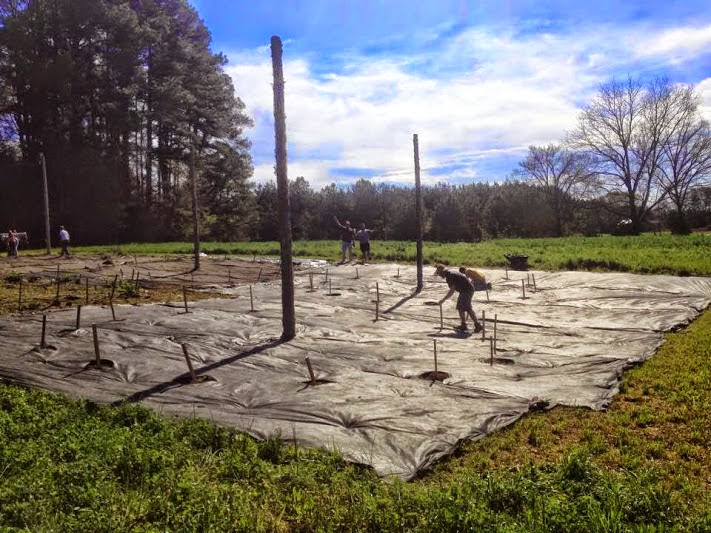In one of the communities I follow over on Google+, I came across this photo of a hop yard in New Jersey. My connection Brad (this is his photo) was highlighting the addition of two new poles, for a total of six poles, which are surrounded by a circle of 15 plants each.
The land is on a hillside, part of a county-owned farm there. Brad says they are growing Cascade, Chinook, Nugget, and Mt. Hood, although there may be one more variety in the mix. Most of the production will go to brewing club members.
When we were first conceptualizing Hawksbill Hop Yards, we considered this traditional arrangement of the plants. You can get pretty good density with this approach, which would allow you to get to commercial production levels. However, once we started having a look at the scale we were going for - a full acre with expansion to a second acre, this arrangement didn't work anymore, since it would make laying the irrigation system difficult, and operating machines in there would be a challenge.
The other system we looked at, but didn't adopt, is the in-line system shown in the photo of a model one of the vendors brought to the hops conference in North Carolina last month. Neighbor Dan also uses this type of system in his hop yard, supporting his Beaver Run Brewery operation. This approach simplifies the irrigation and equipment problems, but it is costly if you don't have a ready and cheap supply of poles - because you are using poles on every row to support the trellis cables.
Our system, which I'll be showing off soon - we're digging holes for the poles right now- is a matrix, with poles every four rows. The system is stabilized through the combination of lengthwise and crosswise cables that are all anchored on the exterior.
In any of these arrangements, despite the challenges each presents, a hops farmer can get densities of up to 1,000 plants per acre. We're planting Hawksbill Hop Yards on a less dense approach, since we're in a learning stage and don't want to add stress to the plants.
I could be convinced to put in a couple of central pole set-ups, but they would be for non-production plants. We could use them for rhizome cultivation, educational outreach, or ceremonially. I like the looks of it, so I'll keep it in mind.


No comments:
Post a Comment